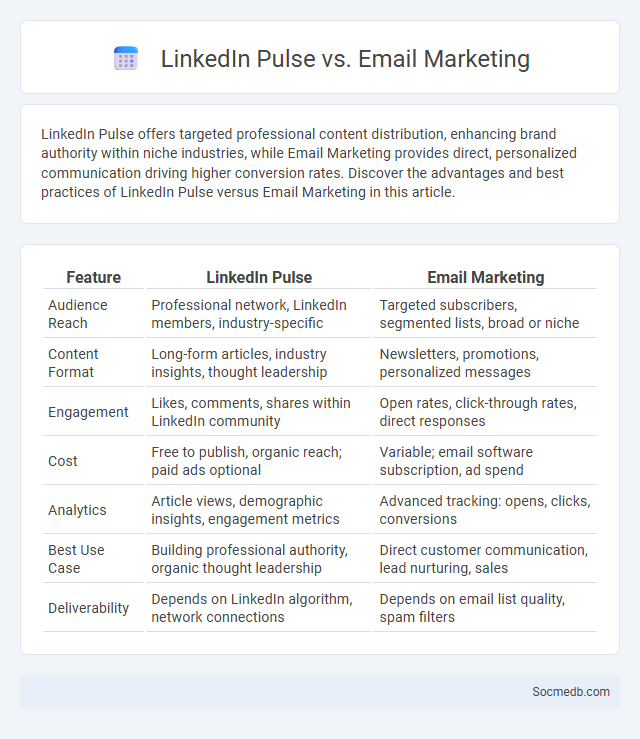
Photo illustration: LinkedIn Pulse vs Email Marketing
LinkedIn Pulse offers targeted professional content distribution, enhancing brand authority within niche industries, while Email Marketing provides direct, personalized communication driving higher conversion rates. Discover the advantages and best practices of LinkedIn Pulse versus Email Marketing in this article.
Table of Comparison
| Feature | LinkedIn Pulse | Email Marketing |
|---|---|---|
| Audience Reach | Professional network, LinkedIn members, industry-specific | Targeted subscribers, segmented lists, broad or niche |
| Content Format | Long-form articles, industry insights, thought leadership | Newsletters, promotions, personalized messages |
| Engagement | Likes, comments, shares within LinkedIn community | Open rates, click-through rates, direct responses |
| Cost | Free to publish, organic reach; paid ads optional | Variable; email software subscription, ad spend |
| Analytics | Article views, demographic insights, engagement metrics | Advanced tracking: opens, clicks, conversions |
| Best Use Case | Building professional authority, organic thought leadership | Direct customer communication, lead nurturing, sales |
| Deliverability | Depends on LinkedIn algorithm, network connections | Depends on email list quality, spam filters |
Introduction: Comparing LinkedIn Pulse, Email Marketing, and Pulse
LinkedIn Pulse offers a professional platform for content sharing and networking, while Email Marketing directly targets your audience with personalized messages and measurable engagement metrics. Pulse, as a real-time news aggregation service, provides up-to-date industry insights but lacks the personalized interaction of email campaigns or LinkedIn's professional network. Understanding the unique strengths of each channel helps you optimize your social media and marketing strategies for maximum impact.
Audience Reach and Targeting Capabilities
Social media platforms offer unparalleled audience reach by connecting with billions of active users worldwide across diverse demographics and interests. Advanced targeting capabilities enable advertisers to precisely segment audiences based on factors such as age, location, behavior, and engagement patterns, maximizing campaign effectiveness. Leveraging data-driven algorithms enhances personalization and improves conversion rates, making social media marketing a powerful tool for businesses aiming to expand their customer base.
Content Format and Versatility
Social media platforms support diverse content formats including images, videos, stories, reels, and live streams to enhance user engagement and reach. Versatile content adapts to platform-specific algorithms and audience preferences, maximizing visibility and interaction. Brands leveraging mixed formats benefit from increased brand awareness, higher engagement rates, and improved conversion metrics.
Engagement and Interaction Rates
High engagement and interaction rates on social media platforms reflect strong audience connection and content relevance. Metrics such as likes, comments, shares, and click-through rates provide valuable insights into user behavior and campaign effectiveness. Optimizing posts for engagement increases visibility and fosters community growth, driving better brand awareness and customer loyalty.
Analytics and Performance Tracking
Social media analytics provides crucial insights into audience behavior, engagement rates, and content effectiveness, enabling data-driven decision making. Performance tracking tools measure key metrics such as reach, impressions, click-through rates, and conversion rates to optimize campaigns in real time. Advanced platforms offer sentiment analysis and competitor benchmarking to refine social strategies and maximize return on investment.
Cost-Effectiveness of Each Platform
Social media platforms vary significantly in cost-effectiveness, with Facebook and Instagram offering robust advertising tools that deliver high ROI through precise audience targeting and budget flexibility. TikTok provides an emerging cost-efficient option by leveraging viral content potential and lower ad costs, ideal for reaching younger demographics. Understanding these platform-specific advantages helps you optimize your marketing budget for maximum engagement and conversions.
Integration with Other Marketing Channels
Social media integration with other marketing channels enhances brand consistency and amplifies campaign reach by delivering unified messages across platforms such as email, content marketing, and paid advertising. Leveraging tools like CRM systems and marketing automation software enables seamless data synchronization, improving customer engagement and conversion tracking. Cross-channel strategies significantly increase ROI by driving higher traffic volumes and fostering stronger audience connections.
Content Lifespan and Visibility
Content lifespan on social media varies significantly by platform, with Twitter posts having a visibility window of approximately 18 minutes, while Facebook and Instagram posts remain visible for up to 48 hours. Algorithm-driven feeds prioritize recent and engaging content, impacting how long a post stays relevant and seen by audiences. Understanding these dynamics enables marketers to optimize posting schedules and enhance content visibility for maximum engagement.
Lead Generation and Conversion Potential
Social media platforms offer powerful tools for lead generation by targeting specific demographics with tailored content and ads, driving higher engagement rates. Your brand's conversion potential increases when these platforms are leveraged to nurture relationships through personalized messaging and retargeting strategies. Optimizing call-to-action buttons and integrating social proof can significantly boost the efficiency of turning leads into paying customers.
Choosing the Right Platform for Your Marketing Goals
Selecting the right social media platform for your marketing goals significantly impacts your campaign's success. Platforms like Instagram and TikTok excel for visually-driven brands targeting younger demographics, while LinkedIn suits B2B businesses aiming to connect with professionals. Understanding your target audience's preferences and the unique features of each platform ensures your marketing strategy delivers maximum engagement and ROI.
 socmedb.com
socmedb.com